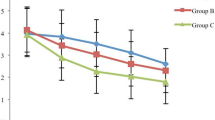Summary
The aim of this study was to figure out the predictors of early postoperative catheter-related bladder discomfort (CRBD) after urological surgery. We designed a prospective observational study in our hospital. Consecutive adult patients undergoing surgery under general anaesthesia or epidural anaesthesia necessitating urinary catheterization were included during a 3-month period. severity of bladder discomfort was assessed on a 4-point scale: (1) no pain, (2) mild pain (revealed only by interviewing the patient), (3) moderate (a spontaneous complaint by the patient of a burning sensation in the urethra and/or an urge to urinate and/or sensation of urethral foreign body without any emotional agitation) and (4) severe discomfort (agitation, loud complaints and attempt to remove the bladder catheter associated with a burning sensation in the urethra). Predictors of CRBD were identified by univariate and multivariate analysis. Totally, 116 patients were included, of which 84.5% had CRBD (mild CRBD: 40.5%; moderate or severe CRBD: 44.0%) at day 1, while 31.9% developed CRBD (mild CRBD: 29.3%; moderate or severe CRBD: 2.6%) at day 3. We evaluated 9 potential forecast factors of CRBD, and univariate Chi-square test showed male gender [OR=2.4, 95%CI (1.1–5.6), P<0.05], abdominal open surgery compared with transurethral surgery [OR=0.3, 95%CI (0.1–0.6), P<0.05], abdominal surgery compared with laparoscopic surgery [OR=3.3, 95%CI (1.2–8.9), P<0.05] and history of catheterization [OR=0.5, 95%CI (0.2–0.9), P<0.05] were independent predictors of moderate or severe CRBD in the patients after surgery. While multivariate logistic regression analysis showed that the abdominal open surgery [EXP(B)=3.074, 95%CI (1.3–7.4), P<0.05] and the history of catheterization [EXP(B)=2.458, 95%CI (1.1–5.9), P<0.05] might contribute more to the occurrence of moderate or severe CRBD. In conclusion, this observational study identified that the type of surgery and the history of catheterization might be predictive factors of moderate and severe CRBD after urological surgery.
Similar content being viewed by others
References
Bala I, Bharti N, Chaubey VK, et al. Efficacy of gabapentin for prevention of postoperative catheter-related bladder discomfort in patients undergoing transurethral resection of bladder tumor. Urology, 2012,79(4):853–857
Singh AK, Bhatt BP, Sundaram PK, et al. Planting geometry to optimize growth and productivity in faba bean and soil fertility. J Environ Biol, 2013,34(1):117–122
Tauzin-Fin P, Stecken L, Sztark F. Catheter-related bladder discomfort in post-anaesthesia care unit. Ann Fr Anesth Reanim (French), 2012,31(7–8):605–608
Sun JL, Lu YP, Huang B, et al. Effect of a novel analgesic disposable urinary catheter in prevention of restlessness caused by catheter-related bladder discomfort in general anesthesia patients in recovery period. Zhonghua Yi Xue Za Zhi (Chinese), 2008,88(25):1750–1752
Andersson K, Wein A. Pharmacology of the lower urinary tract: basis for current and future treatments of urinary incontinence. Pharmacol Rev, 2004,56(4):581–631
Agarwal A, Dhiraaj S, Singhal V, et al. Comparison of efficacy of oxybutynin and tolterodine for prevention of catheter related bladder discomfort: a prospective, randomized, placebo-controlled, double-blind study. Br J Anaesth, 2006,96(3):377–380
Agarwal A, Raza M, Singhal V, et al. The efficacy of tolterodine for prevention of catheter-related bladder discomfort: a prospective, randomized, placebo-controlled, double-blind study. Anesth Analg, 2005,101(4):1065–1067
Agarwal A, Dhiraaj S, Pawar S, et al. An evaluation of the efficacy of gabapentin for prevention of catheter-related bladder discomfort: a prospective, randomized, placebo-controlled, double-blind study. Anesth Analg, 2007,105(5):1454–1457
Binhas M, Motamed C, Hawajri N, et al. Predictors of catheter-related bladder discomfort in the post-anaesthesia care unit. Ann Fr Anesth Reanim, 2011,30(2):122–125
Krane L, Bhandari M, Peabody J, et al. Impact of percutaneous suprapubic tube drainage on patient discomfort after radical prostatectomy. Eur Urol, 2009,56(2):325–330
Tewari A, Rao S, Mandhani A. Catheter-less robotic radical prostatectomy using a custom-made synchronous anastomotic splint and vesical urinary diversion device: report of the initial series and perioperative outcomes. BJU Int, 2008,102(8):1000–1004
Agarwal A, Yadav G, Gupta D, et al. Evaluation of intra-operative tramadol for prevention of catheter-related bladder discomfort: a prospective, randomized, double-blind study. Br J Anaesth, 2008,101(4):506–510
Tauzin-Fin P, Sesay M, Svartz L, et al. Sublingual oxybutynin reduces postoperative pain related to indwelling bladder catheter after radical retropubic prostatectomy. Br J Anaesth, 2007,99(4):572–575
Lepor H, Nieder A, Fraiman M. Early removal of urinary catheter after radical retropubic prostatectomy is both feasible and desirable. Urology, 2001,58(3):425–429
Tan G, Chan S, Ho C. Is transurethral catheterisation the ideal method of bladder drainage? A survey of patient satisfaction with indwelling transurethral urinary catheters. Asian J Surg, 2010,33(1):31–36
Shorrab A, Abol-Enein A, Shabana A, et al. Discomfort following transurethral cystoscopy and catheterization: effects of gender and topical steroids. Eur J Anaesthesiol, 2009,26(7):615–616
Author information
Authors and Affiliations
Corresponding author
Rights and permissions
About this article
Cite this article
Li, C., Liu, Z. & Yang, F. Predictors of catheter-related bladder discomfort after urological surgery. J. Huazhong Univ. Sci. Technol. [Med. Sci.] 34, 559–562 (2014). https://doi.org/10.1007/s11596-014-1315-z
Received:
Revised:
Published:
Issue Date:
DOI: https://doi.org/10.1007/s11596-014-1315-z




